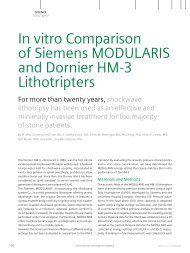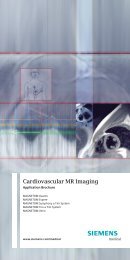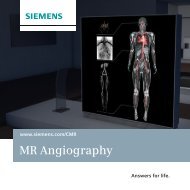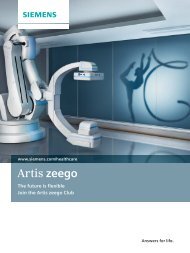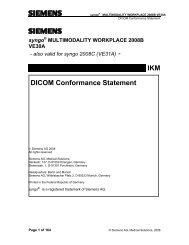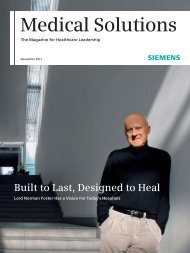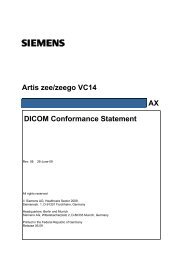SOMATOM Sensation 4 Application Guide - Siemens Healthcare
SOMATOM Sensation 4 Application Guide - Siemens Healthcare
SOMATOM Sensation 4 Application Guide - Siemens Healthcare
Create successful ePaper yourself
Turn your PDF publications into a flip-book with our unique Google optimized e-Paper software.
OverviewOverview ............................ 3From the Editor....................... 8HeartView CT ....................... 10Bolus Tracking....................... 46Dental CT .......................... 52Osteo CT ........................... 56Pulmo CT........................... 60Perfusion CT ........................ 64Interventional CT .................... 70Trauma............................. 76CARE Dose ......................... 80Appendix ........................... 82General Considerations............... 8913
ContentsInterventional CT .................. 70■ The basics ....................... 70■ How to do it ..................... 71- Biopsy- BiopsyCombine- CARE Vision CT■ Additional important information ..... 74Trauma ............................ 76■ The basics ....................... 76■ How to do it ..................... 77- Polytrauma- Trauma■ Additional important information ..... 79CARE Dose ........................ 80■ The basics ............... ....... 80■ How does it work ................. 80■ Additional important information .... 8146
ContentsAppendix ......................... 82■ BodyPerfCT and BodyDynCT ....... 82■ Osteo CT ........................ 83■ Pulmo CT ........................ 85General Considerations ............ 8975
From the EditorDear <strong>SOMATOM</strong> <strong>Sensation</strong> 4 user,we would like to present you our application guide forspecial protocols.To improve future versions of this application guide andthe examination protocols, we would highly appreciateyour questions, suggestions and comments.Please contact us:somatom.examinationprotocol@siemens.comWe express our sincere gratitude to the many customerswho contributed valuable input.Special thanks to Loke-Gie Haw, Claudia Scherf,Bernd Ohnesorge, Christoph Suess, Lutz Guendel,Dr. Martin Heuschmid, and Ernst Klotz for theirvaluable assistance.8
HeartView CTTo minimize motion artifacts in cardiac images, the followingtwo requirements are mandatory for a CT system:• Fast gantry rotation time in order to achieve fast imageacquisition time• Prospective synchronization of image acquisition orretrospective reconstruction based on the ECG recordingin order to produce the image during thediastolic phase when the least motion happens.Fig. 9:500 ms scan without ECG-TriggerFig. 10:500 ms scan with ECG-TriggerFig. 11:250 ms scan with ECG-Trigger11 13
HeartView CTTemporal resolutionTemporal resolution, also called time resolution, representsthe time window of the data that is used for imagereconstruction. It is essential for cardiac CT imaging – thehigher the temporal resolution, the fewer the motionartifacts. With the <strong>SOMATOM</strong> <strong>Sensation</strong> 4, temporalresolution for cardiac imaging can be achieved at down to125 ms.Technical principlesBasically, there are two different technical approaches forcardiac CT acquisition:• Prospectively ECG triggered sequential scanning (Fig. 12).• Retrospectively ECG gated spiral scanning (Fig. 13).ImagesZ-PositionScanTimeScanFeedDelayR R R RECGFig. 12Z-PositionContinuousSpiral Scan & Feed“3D“ Image data“3D“ Image dataDelayR R R RReconReconReconECGReconTimeFig. 1312 14
HeartView CT1. For LCA (Left Coronary Artery)HR [bpm] T-Reverse [msec] RR-Delay [%]40-59 -450 50%60-65 -400 55%> 65 -350 55%2. For RCA (Right Coronary Artery)HR [bpm] T-Reverse [msec] RR-Delay [%]40-59 -450 50%60-65 -400 55%> 65 -500 40%3. For image reconstruction in the systolic phase, useabsolute delay of 100 ms.Preview Series ReconstructionPreview series can be used to define optimal time windowbefore the full series reconstruction. Click on the previewseries button in the Trigger card. The slice position of thepreview series is based on the currently displayed imagein the tomogram segment, which has to be chosen bythe user.ECG trace editorThe ECG trace editor is used for adaption of image reconstructionto irregular heart rates. This editing tool can beused after the scan is aquired. By using the right mousemenu on the Trigger card you can use several modificationtools for the ECG Sync, such as Delete, Disable, Insert.Toreset the ECG curve select the check box Original ECG.15 17
HeartView CTECG PulsingECG Pulsing is a dedicated technique used for onlinedose modulation for Cardiac imaging. The tube currentis ECG-controlled and reduced during systolic phases ofthe cardiac cycle while maintained normal during diastolicphases when best image quality is required (Fig. 1). Asshown in figure 2, essential dose reduction up to 50%can be achieved. It can be switched on/off by the user(Fig. 3).Fig. 1:Image acquisition and reconstruction in diastolic phase and systolic phase.Fig. 2:Dose modulation with ECG pulsing.Fig. 316 18
HeartView CTCardioCAREThis is a dedicated cardiac filter which can reduce imagenoise thus provides the possibility of dose reduction.It is applied in a pre-defined scan protocol called“CoronaryCARE.” As shown in figure 1, the comparableimage quality can be achieved with a dose reduction of30%.abFig. 1a:Image acquired with 400 effective mAs.Fig. 1b:Image acquired with 266 effective mAs and Cardio CARE filter.CardioSharpThis is a dedicated reconstruction kernel used forbetter edge definition in coronary artery imaging. It isapplied in a pre-defined cardiac scan protocol called“CoronarySharp.” Image examples are shown in figure 1.abFig. 1:Image reconstructed with (1b) and without (1a) Cardio Sharp kernel.17 19
HeartView CTEffective mAs:In sequential scanning, the dose (D seq) applied to thepatient is estimated as the product of the tube currenttime(mAs) and the CTDIw per mAs:D seq = D CTDIw x mAsIn spiral scanning, however, the applied dose (D spiral ) isinfluenced additionally by the pitch factor. For example, ifa multislice CT scanner (4-slice) is used, the actual doseapplied to the patient in spiral scanning will be decreasedwhen pitch is larger than 4, and increased when pitch issmaller than 4. Therefore, the dose in spiral scanning hasto be corrected by the pitch factor:D spiral = (D CTDIw x mAs) /pitchTo make it easier for the users, the concept of “EffectivemAs” was introduced with the <strong>SOMATOM</strong> <strong>Sensation</strong> 4.The Effective mAs takes into account the influence ofpitch on both the image quality and dose:Eff. mAs = mAs x 4 / pitchTo calculate the dose on the <strong>SOMATOM</strong> <strong>Sensation</strong> 4,you simply have to multiply the CTDIw per mAs with theeffective mAs:D spiral, VZ = D CTDIw x Eff. mAsThe Effective mAs can be selected by the user for a definedimage quality and dose, independent of pitch. The tubecurrent will be adapted according to:4-slice modes: mA = (Eff. mAs/Rotation time) x (Pitch/4)2-slice modes: mA = (Eff. mAs/Rotation time) x (Pitch/2)You should change the mAs according to the patient size,however when the tube load (mA) reaches its highestlimitation, the “Scan Assistant” will be available to giveyou the possibility to adjust either the scan time or themAs value.You should always define the scan range before youchange the mAs.18 20
HeartView CTDose information:The dose as described by CTDIw is displayed on the userinterface for the selected scan parameters. The CTDI ismeasured in the dedicated plastic phantoms – 16 cm diameterfor head and 32 cm diameter for body (as definedin IEC 60601 - 2 - 44).This dose number gives a good estimatefor the average dose applied in the scanned volumeas long as the patient size is similar to the size of the respectivedose phantoms.Since the body size can be smaller or larger than 32 cm,the CTDI value displayed can deviate from the dose in thescanned volume.The CTDIw value does not provide the entire informationof the radiation risk associated with the CT examination.For this purpose, the concept of the “Effective Dose”was introduced by ICRP (International Commission onRadiation Protection). The effective dose is expressed asa weighted sum of the dose applied not only to theorgans in the scanned range, but also to the rest of thebody. It could be measured in whole body phantoms(Alderson phantom) or simulated with Monte Carlo techniques.The calculation of the effective dose is rather complicatedand has to be done by sophisticated programs. Thesehave to take into account the scan parameters, thesystem design of individual scanner, such as x-ray filtrationand gantry geometry, the scan range, the organs involvedin the scanned range and the organs affected by scatteredradiation. For each organ, the respective dose deliveredduring the CT scanning has to be calculated and thenmultiplied by its radiation risk factor. Finally the weightedorgan dose numbers are added up to get the effectivedose.The concept of effective dose would allow the comparisonof radiation risk associated with different CT or x-rayexams, i. e. different exams associated with the sameeffective dose would have the same radiation risk for thepatient. It also allows comparing the applied x-ray exposureto the natural background radiation, e. g. 2-3 mSv per yearin Germany.For most of our scan protocols, we calculated the effectivedose numbers for standard male * and female * andlisted the result in the description of each scan protocol.21 19
HeartView CTThe calculation was done by the commercially availableprogram “WinDose”(Wellhoefer Dosimetry) – as shownin figure 1-3.Fig. 1: User interface of the PC program WinDose. All parametersnecessary for the effective dose calculation have to be specified.Fig. 2: A graphic interface of WinDose allows to specify the anatomicalscan range.20 22
HeartView CTFig. 3: Results as output of WinDose with the organ dose readingsand the effective dose according to ICRP26 (previous version) and ICRP60(currently valid).* The Calculation of Dose from External Photon Exposures UsingReference Human Phantoms and Monte Carlo Methods. M. Zankl et al.GSF report 30/9123 21
HeartView CT■ How to do itCalcium scoringThis application is used for identification and quantificationof calcified lesions in the coronary arteries. Itcan be performed with both ECG triggering (sequentialscanning) and gating (spiral scanning) techniques. Thefollowing scan protocols are predefined:• CaScoreSeq- Sequential scanning protocol with ECG triggering• CaScoreSpiStd- Standard spiral scanning protocol with ECG gating,using a pitch of 1.5• CaScoreSpiFast- Fast spiral scanning protocol with ECG gating, usinga pitch of 1.822 24
HeartView CTHints in general:• Kernel B35f is dedicated to calcium scoring studies.To ensure the best image quality and correlation toknown reference data, other kernels are not recommended.• Use the ECG triggered protocol generally except forpatients with arrhythmia. Use the ECG gated protocolwhen accuracy and/or reproducibility are essential, e. g.follow-up studies of calcium scoring or comparisonstudies with conventional angiography.• The standard protocol (pitch 1.5) is recommended wheneverthe entire scan range can be covered within a singlebreathhold and the heart rate is greater than 40 bpm.• The fast protocol (pitch 1.8) can be applied when theheart rate is consistently greater than 80 bpm.Placement of ECG Electrodes (Fig. 18):1. Right arm (RA):on the right mid-clavicular line, directly below the clavicle2. Left arm (LA):on the left mid-clavicular line, directly below the clavicle3. Left leg (LL):on the left mid-clavicular line, at the 6 th or 7 th intercostalspace.Fig. 1825 23
HeartView CTCaScoreSeqIndications: This is a sequential scanning protocol usingan ECG triggering technique for coronary calcium scoringstudies.Topogram: AP, 512 mm.From the carina until the apexof the heart.A typical range of 12 cmcovering the entire heart canbe done in 20-30 s (dependson heart rate).Fig. 19kV 120Effective mAs 35Slice collimation4 x 2.5 mmSlice width2.5 mmFeed/Scan10 mmRotation time0.5 sTemporal resolution 250 msKernelB35fCTDIw3.3 mGyScan range117.5 mmEffective Dosemale: 0.5 mSvfemale: 0.8 mSvIf you apply API for image acquisition, please make surethat the breath-hold interval in the Patient Model Dialog islonger than the total scan time, e. g. 50 s, otherwise theimage acquisition will be interrupted by the default breathholdinterval. This does not apply when API is not activated.Fig. 20 Fig. 2124 26
HeartView CTCaScoreSpiStdIndications: This is a standard spiral scanning protocol,using an ECG gating technique for coronary calcium scoringstudies.Topogram: AP, 512 mm.From the carina until the apexof the heart.A typical range of 12 cmcovering the entire heart canbe done in 16 s.Fig. 22kV 120Effective mAs 133Slice collimation4 x 2.5 mmSlice width3 mmFeed/Rotation3.75 mmRotation time0.5 sTemporal resolution Up to 125 ms*KernelB35fIncrement1.5 mmCTDIw12.5 mGyScan range120 mmEffective Dosemale: 2.2 mSvfemale: 3.2 mSv*Depends on heart rate.Fig. 23: Scan 1:67 mm 3 Fig. 24: Scan 2:64 mm 327 25
HeartView CTCaScoreSpiFastIndications: This is a fast spiral scanning protocol, using anECG gating technique for coronary calcium scoring studies.Topogram: AP, 512 mm.From the carina until the apexof the heart.A typical range of 12 cmcovering the entire heart canbe done in 14 s.kV 120Effective mAs 110Slice collimation4 x 2.5 mmSlice width3 mmFeed/Rotation4.5 mmRotation time0.5 sTemporal resolution Up to 125 ms *KernelB35fIncrement1.5 mmCTDIw10.3 mGyScan range120 mmEffective Dosemale: 1.8 mSvfemale: 2.7 mSv*Depends on heart rate.26 28
HeartView CTFig. 26Fig. 2727 29
HeartView CTCoronary CTAThis is an application for imaging of the coronary arterieswith contrast medium. It can be performed with bothECG triggering and gating techniques.The following scanprotocols are predefined:• ECGTrigCTA- Sequential scanning protocol with ECG triggering.• CoronaryStd- Standard spiral scanning protocol with ECG gating,using a pitch of 1.5.• CoronaryFast- Fast spiral scanning protocol with ECG gating, usinga pitch of 1.8.• CoronaryCARE- Spiral scanning protocol with ECG gating anddedicated cardiac filter (Cardio CARE) which reducesimage noise thus makes dose reduction possible.• CoronarySharp- Spiral scanning protocol with ECG gating anddedicated reconstruction kernel for better edgedefinition in coronary artery imaging.General Hints:• Generally speaking, the ECG gated protocol is recommendedfor premium image quality of the coronaryarteries, and whenever 3D postprocessing, such asMPR, VRT or Fly through, is required.• Always use the ECG gated protocol for patient witharrhythmia.• The ECG triggered protocol is recommended whenimage acquisition for a longer range is necessary and itcan not be completed by spiral scanning within a singlebreathhold, e.g. coronary bypass, or, if the heart rate isless than 40 bpm.• The ECG gated fast protocol using a pitch of 1.8 can beapplied if the heart rate is greater than 80 bpm consistently.• The ECG gated standard protocol using a pitch of 1.5 isrecommended whenever the entire scan range can becompleted within a single breathhold.28 30
HeartView CTECGTrigCTAIndications: This is a sequential scanning protocol with anECG triggering technique for coronary CTA studies. It couldalso be applied for aortic CTA studies, e.g. aortic dissection.Topogram: AP, 512 mm.From the aortic arch until theapex of the heart.A range of 16 cm can becovered in 32 s.Fig. 28kV 120Effective mAs 120Slice collimation4 x 2.5 mmSlice width2.5 mmFeed/Scan10 mmRotation time0.5 sTemporal resolution 250 msKernelB30fCTDIw11.3 mGyScan range117.5 mmEffective Dosemale: 1.8 mSvfemale: 2.7 mSvIf you apply API for a single breathhold acquisition, pleasemake sure that the breathhold interval in the PatientModel Dialog is longer than the total scan time, e. g. 50 s,otherwise the image acquisition will be interrupted by thedefault breathhold interval. This does not apply when APIis not activated. For longer ranges, e. g. the entire thoracicaorta, that can not be acquired within a single breathhold,please ensure that the breathhold interval in the PatientModel Dialog is set up correctly, according to the patient’slevel of cooperation.Fig. 29 Fig. 3031 29
HeartView CTCoronaryStdIndications: This is a standard spiral scanning protocolwith an ECG gating technique for coronary CTA studies.Topogram: AP, 512 mm.Approximately, from thecarina until the apex of theheart.A typical range of 10 cmcovering the entire heart canbe done in 34 s.Fig. 31kV 120Effective mAs 400Slice collimation4 x 1 mmSlice width1.25 mmFeed/Rotation1.5 mmRotation time0.5 sTemporal resolution Up to 125 ms *KernelB30fIncrement0.8 mmCTDIw45.6 mGyScan range120 mmEffective Dosemale: 7.6 mSvfemale: 11.1 mSv*Depends on heart rate.Fig. 32 Fig. 3332
HeartView CTCoronaryFastIndications: This is a fast spiral scanning protocol using apitch of 1.8 with an ECG gating technique for coronaryCTA studies.Topogram: AP, 512 mm.Approximately, from thecarina until till the apex ofthe heart.A typical range of 10 cmcovering the entire heart canbe done in 28 s.Fig. 34kV 120Effective mAs 330Slice collimation4 x 1 mmSlice width1.25 mmFeed/Rotation1.8 mmRotation time0.5 sTemporal resolution Up to 125 ms *KernelB30fIncrement0.8 mmCTDIw37.6 mGyScan range120 mmEffective Dosemale: 6.3 mSvfemale: 9.2 msv*Depends on heart rate.Fig. 35 Fig. 3633
HeartView CTCoronaryCAREIndications: This is a spiral scanning protocol using ECGgating technique and a dedicated cardiac filter whichcan reduce images noise thus makes the dose reductionpossible for coronary CTA studies.Topogram: AP, 512 mm.Approximately, from thecarina until till the apexof the heart.A typical range of 10 cmcovering the entire heart canbe done in 34 s.kV 120Effective mAs 267Slice collimation4 x 1 mmSlice width1.25 mmFeed/Rotation1.5 mmRotation time0.5 sTemporal resolution Up to 125 ms *KernelB40fIncrement0.8 mmCTDIw30.4 mGyScan range120 mmEffective Dosemale: 5.1 mSvfemale: 7.4 mSv*Depends on heart rate.Image acquired with 400effective mAs.Image acquired with 266 effectivemAs and Cardio CARE filter.34
HeartView CTCoronarySharpIndications: This is a spiral scanning protocol using ECGgating technique and a dedicated cardiac reconstructionkernel for better edge definition in coronary artery imaging.Topogram: AP, 512 mm.Approximately, from thecarina until till the apexof the heart.A typical range of 10 cmcovering the entire heart canbe done in 34 s.kV 120Effective mAs 400Slice collimation4 x 1 mmSlice width1.25 mmFeed/Rotation1.5 mmRotation time0.5 sTemporal resolution Up to 125 ms *KernelB46fIncrement0.8 mmCTDIw45.6 mGyScan range120 mmEffective Dosemale: 7.6 mSvfemale: 11.1 mSv*Depends on heart rate.1a1bImage reconstruction with (1b) andwithout (1a) Cardio Sharp kernel.35
HeartView CTAortic and pulmonary studiesThis application can be used for high-resolution interstitiallung studies with an ECG triggering technique, or whenimaging the aorta and pulmonary arteries with contrastmedium and ECG gating technique. The following scanprotocols are predefined:• LungECGHires- Sequential scanning protocol with ECG triggering.• PulmonaryECG- Spiral scanning protocol with ECG gating, using apitch of 2.General Hints:• The general purpose of these applications is to reducemotion artifacts in the lungs due to the cardiac pulsation.• The LungECGHires protocol is recommended for detectionand localization of the lesions adjacent to the heartor the interlobar fissures.• The PulmonaryECG protocol is recommended for aorticor pulmonary studies, e. g. aorta dissection or pulmonaryemboli. It should not be applied when the heart rate isless than 60 bpm.36
HeartView CTLungECGHiresIndications: This is a sequential scanning protocol withan ECG triggering technique for interstitial studies of thelungs, especially for the lesions in the pericardial region.Topogram: AP, 512 mm.From the apex of the lung tillthe lung base.Arange of 26 cm can becovered in 36 sFig. 37kV 120Effective mAs 120Slice collimation4 x 1 mmSlice width1 mmFeed/Scan15 mmRotation time0.75 sTemporal resolution 375 msKernelB70sCTDIw13.7 mGyScan range300 mmEffective Dosemale: 1.5 mSvfemale: 1.9 mSvFig. 38750 msec,1 mmwithout ECG-triggerFig. 39375 msec,1 mmwith ECG-trigger37
HeartView CTPulmonaryECGIndications: This is a spiral scanning protocol using a pitchof 2 with an ECG gating technique for aortic and pulmonarystudies, e. g. aortic dissection or pulmonary emboli.Topogram: AP, 512 mm.From the aorta arch until thetip of the sternum.A typical range of 15 cm canbe covered in 16 s.Fig. 40kV 120Effective mAs 200Slice collimation4 x 2.5 mmSlice width3 mmFeed/Rotation5 mmRotation time0.5 sTemporal resolution Up to 125 ms *KernelB30fIncrement2 mmCTDIw18.8 mGyScan range300 mmEffective Dosemale: 7.5 mSvfemale: 9.8 mSv*Depends on heart rate.Fig. 41 Fig. 4238
HeartView CT■ Additional important information• While all the other arteries receive arterial blood supplyduring the systolic phase, the coronary arteries are mostappropriately supplied with blood during the diastolicphase. Therefore, for imaging the coronary arteries,image reconstruction is usually performed in the diastolicphase – not only for minimal motion artifact, but also foroptimally filled coronary arteries.• You may see different heart rates displayed on the inroomECG monitor and the monitor on the consolesince they are calculated in different ways:1. On the ECG monitor – the heart rate displayed isbased on the “R-R” intervals for every 15 s.2. On the console – the heart rate displayed for ECGgating is based on every “R-R” interval, and for ECGtriggering, it is based on the average of the previous3 or 5 “R-R” intervals (this can be configured withOption/Configuration/HeartView).• For the LungECGHires protocol, it is recommended touse the cluster scanning mode. You can set up the predefinedbreathhold interval in the “Patient ModelDialog”.• The postprocessed VRT images of the coronary arteriescan be matched according to the “standard projections”of the conventional angiography. Image examples areshown below (Fig. 43-49). For easier comparison, theFig. 43b, 44b and 45b are mirrored.Views which can not be achieved by conventionalangiography are shown in Fig. 50.39
HeartView CTLCA, RAO 15 Fig. 43a Fig. 43bLCA, RAO 30 Fig. 44a Fig. 44bLCA, AP Cranial Fig. 45a Fig. 45bLCA, LAO 60/0 Fig. 46a Fig. 46b40
HeartView CTLCA, LAO 90/0 Fig. 47a Fig. 47bRCA, RAO 30 Fig. 48a Fig. 48bRCA, LAO 60 Fig. 49a Fig. 49bTop view Fig. 50a Base view Fig. 50bViews which can not be achieved by conventional Angiography41
HeartView CT• Why can’t I use a higher pitch for ECG gated scanning?Z-PositionContinuousSpiral Scan & Feed“3D“ Image dataDelayR R R RReconReconReconECGReconTimeFig. 51Z-PositionRecon“3D“ GapReconDelayReconR R R RECGReconTimeFig. 52X: ECG trace (time)Y: Z-positionSlope: Table feed speedIf a higher pitch would be used, gaps will be produced inthe volume acquisition as shown in Fig. 52.42
HeartView CT• By default, the “Synthetic Trigger” (ECG triggeredscanning) or “Synthetic Sync” (ECG gated scanning)is activated for all predefined cardiac scan protocols(Fig. 53 and 54). And it is recommended to keep italways activated for examinations with contrast medium.In case of ECG signal loss during the acquisition, thiswill ensure the continuation of the triggered scans orallows an ECG to be simulated for retrospective gating.If it is deactivated, the scanning will be aborted in caseof ECG signal loss during the acquisition.Fig. 53Fig. 5443
HeartView CT• ACV (Adaptive Cardio Volume) (Fig. 55) is a dedicatedalgorithm for bi-phase image reconstruction. The imagetemporal resolution of 125 ms can be achieved withACV. By default, it is switched on for all coronary CTAscan protocols, and switched off for all calcium scoringscan protocols. And it is not recommend to change thisdefault setting.Fig. 5544
HeartView CT• Calcium Scoring evaluation is performed on a separatesyngo task card:1.The threshold of 130 HU is applied for score calculationby default, however, you can modify it accordingly.2. In addition to the seeding method, you can use freehandROI for the definition of lesions.3. The separation and modification of lesions within adefined volume (depth in mm) can be performed not onlyon 2D slices, but also with 3D editing.4. For easier identification of small lesions, you can blowupthe display.5. You can customize hospital/office information on thefinal report using Report Configuration.6. You can generate HTML report including site specificinformation, free text and clinical images.This then can besaved on floppy disc and/or printed.7. The results are displayed online in a separate segmentincluding the following information:- Area (in mm 3 )- Peak density (in HU)- Volume (in mm 3 )- Calcium mass (mg calcium Hydroxyapatite)- Score (Agatston method)8.The results cab be printed on laser film, paper printer orsaved into data base.45
Bolus tracking■ The basicsThe administration of intravenous (IV) contrast materialduring spiral scanning improves the detection and characterizationof lesions, as well as the opacity of vessels.Thecontrast scan will yield good results only if the acquisitionoccurs during the optimal phase of enhancement in theregion of interest. Therefore, it is essential to initiate theacquisition with the correct start delay. Since multislicespiral CT can provide much faster speed and shorteracquisition time, it is even more critical to get the righttiming to achieve optimal results (Fig. 1a, 1b).40 s scan 10 s scanLonger scan time Fig. 1a Shorter scan time Fig. 1bThe dynamics of the contrast enhancement is determinedby:• Patient cardiac output• Injection rate (Fig. 2a, 2b)• Total volume of contrast medium injected(Fig. 3a, 3b)• Concentration of the contrast medium (Fig. 3b, 4a)• Type of injection – uni-phasic or bi-phasic (Fig. 4a, 4b)• Patient pathology46
Bolus trackingAortic time-enhancement curves after i.v. contrast injection(computer simulation*).All curces are based on the same patient parameters(male, 60-year-old, 75 kg).2 ml/s,120 ml, 300 mg I/ml Fig. 2a 4 ml/s,120 ml, 300 mg I/ml Fig. 2b80 ml, 4 ml/s, 300 mg I/ml Fig. 3a 120 ml, 4 ml/s, 300 mg I/ml Fig. 3bUni-phaseFig. 4a140 ml, 4 ml/s, 370 mg I/mlBi-phase70 ml, 4 ml/s, plus 70 ml,2 ml/s, 370 mg I/mlFig. 4b*Radiology 1998; 207:647-65547
Bolus tracking■ How to do itTo achieve optimal results in contrast studies, use ofCARE Bolus is recommended (optional). In case it is notavailable, use Test Bolus.CARE Bolus (optional)This is an automatic bolus tracking program, which enablestriggering of the spiral scanning at the optimal phase ofthe contrast enhancement.General Hints:1.This mode can be applied in combination with any spiralscanning routine protocol. Simply insert “Bolus tracking”by clicking the right mouse button in the chronicle. Thisinserts the entire set up including pre-monitoring, i. v.bolus and monitoring scan protocol. You can also save theentire set up as your own scan protocols (please refer tothe application guide for routine protocols).2.The pre-monitoring scan is used to determine the levelof monitoring scans. It can be performed at any level ofinterest. You can even predefine several pre-monitoringscans by defining a short range and then selecting theoptimal image in which to place the trigger ROI. You canalso increase the mAs setting to reduce the image noisewhen necessary.3.To achieve the shortest possible spiral start delay (2 s),the position of the monitoring scans relative to thebeginning of spiral scan must be optimized. A “snapping”function is provided:• After the Topogram is performed, the predefined spiralscanning range and the optimal monitoring position willbe shown.• If you need to redefine the spiral scanning range, youshould also reposition the monitoring scan in order tokeep the shortest start delay time (2 s). (The distancebetween the beginning of the spiral scanning range andthe monitoring scan will be the same).• Move the monitoring scan line towards the optimalposition and release the mouse button, it will be snappedautomatically. (Trick: if you move the monitoring scanline away from the optimal position the “snapping”mechanism will be inactive).48
Bolus tracking4. Place an ROI on the target area or vessel used fortriggering. (The ROI is defined with double circles – theouter circle is used for easy positioning, and the innercircle is used for the actual evaluation).You can also zoomthe reference image for easier positioning of the ROI.5. Set the appropriate trigger threshold, and initiate thecontrast injection and monitoring scans at the same time.During the monitoring scans, there will be simultaneousdisplay of the relative enhancement of the target ROI.When the predefined density is reached, the spiral acquisitionwill be triggered automatically.6. You can also initiate the spiral any time during themonitoring phase manually – either by pressing the STARTbutton or by clicking the START key.If you do not want to use automatic triggering, you canset the trigger level to its maximum (800 HU), and startthe trigger manually.If you would like more information on this option, pleasecontact your local <strong>Siemens</strong> representative. If you do nothave this option, you can also use the “Test Bolus”.An image example is shown below (Fig. 5).Abdominal aortic aneurysm (MIP) Fig. 549
Bolus trackingTest BolusIndications: This mode can be used to test the start delayof an optimal enhancement after the contrast mediuminjection.TestBoluskV 120mAs 30Slice collimation 4 x 2.5Slice width 10Feed/Rot. 0Rot. time 0.5 s/0.75 s*KernelB40fCycle time2 s* For <strong>SOMATOM</strong> <strong>Sensation</strong> 4 with maximum gantry rotation speed of 0.75 s per rotation.<strong>Application</strong> procedures:1. Select the spiral mode that you want to perform,and then “Append” the TestBolus mode under Specialprotocols.2. Insert the Test Bolus mode above the spiral mode forcontrast scan by “cut/paste” (with right mouse button).3. Perform the Topogram, and define the slice position forTestBolus.4. Check the start delay, number of scans and cycle timebefore loading the mode.5. A test bolus with 10-20 ml is then administered withthe same flow rate as during the following spiral scan.Start the contrast media injection and the scan at thesame time.6. Load the images into the Dynamic Evaluation functionand determine the time to the peak enhancement.Alternatively, on the image segment, click “select series”with the right mouse button and position an ROI on thefirst image. This ROI will appear on all images in the testbolus series. Find the image with the peak HU value, andcalculate the time “∆t” taken to reach the peak HU value(do not forget to add the preset start delay time). Thistime can then be used as the optimal start delay time forthe spiral scan.50
Bolus tracking■ Additional important information1.The preset start delay time for monitoring scans dependson whether the subsequent spiral scan will be acquiredduring the arterial phase or venous phase. The defaultvalue is 10 s. You can modify it accordingly.2. It should be pointed out that when using “Test Bolus”,there may be residual contrast in the liver and kidneysprior to scanning. This may result in an inaccurate arterialand equilibrium phase.3. The trigger threshold is not an absolute value but arelative value compared to the non-contrast scan. E. g. ifthe CT value is 50 HU in the non-contrast image, and yourtrigger level is 100 MU, then the absolute CT value in thecontrast image will be 150 HU.4. If you change slice collimation, rotation time or kV inthe spiral scanning protocol after CARE Bolus is inserted,a longer spiral start delay time will be the result, e. g. 14 s.This is due to the necessary mechanical adjustments,e. g. moving the slice collimators. Therefore, it is recommendedthat you modify the parameters of the spiralscanning before inserting the CARE Bolus.5. If API is used in conjunction with CARE Bolus, theactual start delay time for the spiral will be as long as thelength of API including the predefined start delay time.E. g. if the predefined the start delay is 2 s, and the APIlasts 5 s, the spiral will start 5 s after the threshold isreached.6. In case you have to interrupte the monitoring scanningdue to injection problem, you can repeat it afterwards byinserting CARE bolus again with a right mouse click. Thesame Topogram can still be used.51
Dental CTThis is an application package for reformatting panoramicviews and paraxial slices through the upper and lowerjaw. It enables the display and measurement of the bonestructures of the upper and lower jaw (especially for a1:1 scale) as the basis for OR planning in oral surgery.■ The basicsWhat is the relevant anatomical information for oralsurgery planning and dental implantation?• Location of the socket for dental implant,• Buccal and lingual thickness of the corticalcomponent of the alveolar process,• Position of the mandibular canal and the mentalforamen,• Extent of the nasal sinuses and• Position and width of the floor of the nasal cavity.What can Dental CT do?• Reformatting of a curvilinear range of panoramic viewsalong the jaw-bone.• Reformatting of linear views of selectable length and atselectable intervals perpendicular to the panoramic views.• Presentation of results in the form of multiple imagedisplay with reference markings.• Images are documented on film in “life-size” so that thedirect measurement of the anatomic information witha ruler is possible. The layout of the film sheet is predefinedsuch that it can accommodate the maximumnumber of reformatted images.Panoramic view Fig. 1 Paraxial view Fig. 252
Dental CT■ How to do itScan protocol:Dental CTkV 120mAs 70Slice collimation4 x1 mmSlice width1 mmFeed/Rot.2.7 mmRot. time0.75 sKernelH60sIncrement0.8 mmScan range45 mmCTDIw19.3 mGyEffective Dosemale: 0.3 mSvfemale: 0.3 mSv• It is mandatory to position the patient head in the centerof the scan field – use the lateral laser light markerfor positioning.• Gantry tilt is not necessary since you have the possibilityto tilt the reference line to generate an axial reformattedimage at the desired plane. However, in order to minimizethe scan length for the same anatomical region,it is recommended to position the patient’s head at theappropriate scan plane whenever possible:- For the upper and lower jaw:occlusal plane in parallel to the scan plane.- For either jaw:jaw bone in parallel to the scan plane.• It is recommended to end the exam first, and then startthe Dental evaluation.53
Dental CTDelineation of the desired views Fig. 3■ Additional important information• This protocol delivers high resolution images for dentalCT evaluation, however, you can also reconstruct imageswith softer kernel, e.g. H20s, for 3D/SSD postprocessing.AP-cranial view Fig. 4a Caudal view Fig. 4b54
Dental CT• Image orientation:- In the paraxial view, a “B” indicates buccal and a “L”lingual. The lingual marker “+” must always be positionedat the tongue. If not, simply drag & drop it back.- In the panoramic view, a “B” stands for “Begin” and an“E” for “End”.• Since Dental CT provides you with the possibility togenerate the curved MPR in a range, you may try to useit for the evaluation of the other anatomic region, suchas vessels.• Filming: for the maximum use of the film, film directlyfrom the dental card instead of Patient Browser.For easy reprinting, the results of the latest Dental CTFilm are stored in the Pateint Browser in the folder“Film”.• It is better to change the image windowing on the virtualfilm sheet.• A semi-automatic detection tool can be used to markand outline the mandibular canal on both paraxial andpanoramic images for easy viewing and filming.• Multiple paraxial ranges can be defined on one referenceimage by “cluster & copy function”. I. e., you can groupa number of paraxial lines and copy the lines to anotherlocation, e. g. over individual sockets at different locations(Fig.5).• ROI definition for statistical evaluations and deletion ofgraphics are possible.Fig. 555
Osteo CTThis is an application package for the quantitative assessmentof vertebral bone mineral density for the diagnosisand follow-up of osteopenia and osteoporosis.■ The basicsThis program enables the quantitative determination ofbone mineral density of the spine in mg/ml of calciumhydroxyapatite (CaHA) for the diagnosis, staging, andfollow-up of osteopenia and osteoporosis with CT. Thepatient is scanned together with the water- and boneequivalentcalibration phantom.What is “T-score”?This is the deviation of average BMD of the patient fromthat of a young healthy control. It represents bone losswith reference to the peak bone mass.What is “Z-score”?This is the deviation of average BMD of the patient fromthat of a healthy person of the same age. It is an indicatorof biological variability.<strong>Siemens</strong> reference data:The <strong>Siemens</strong> reference data was acquired at threeEuropean centers, including 135 male and 139 femalesubjects, 20 to 80 years of age.56
Osteo CT■ How to do itOsteoOsteoObesekV 80 80mAs 125 350Slice collimation 4 x2,5 mm 4 x 2,5 mmSlice width 10 mm 10 mmFeed/Rot. 0 mm 0 mmRot. time 0.5 s/0.75 s* 1.5 sKernel S80f S80fCycle time 3 s 3 sCTDIw 3.6 mGy 10.2 mGyEffective Dose male: 0.03-0.04 mSv male: 0.1 mSvfemale: 0.05-0.1 mSv female: 0.1-0.3 mSv* For <strong>SOMATOM</strong> <strong>Sensation</strong> 4 with maximum gantry rotation speed of 0.75 s per rotation.Patient positioning:• Set the table height at 125.The gantry tilt will be availablefrom –28.5° to +30°.• Patients should be positioned so they are as parallelto the patient table as possible. Support the knees tocompensate for lordosis.• The calibration phantom should be positioned directlybelow the target region. Put the Gel-pad between thecalibration phantom and the patient to exclude airpockets.Scanning:• Typically, one scan each is performed at L1, L2 andL3 levels. It is recommended to use image commentsL1, L2, L3 prior to scanning. These comments will bedisplayed with the Osteo evaluation results.Note: no blanks or other deviations are allowed for thecomments, e.g. use L3 instead of L 3, or T12 instead ofTH12.• Before ending the examination, you can drag&dropthe chronicles to the topogram segment to get theTopographics, i. e. the cut-lines for each vertebra on thetopogram.57
Osteo CT• Select the appropriate scan protocol according to thepatient size, i. e. use “OsteoObese” for obese patient.• Position the cut line of scanning through the middle ofthe vertebra, i. e. bi-sector between the angle of theupper and lower end plate.• The phantom must be included in the FOV of theimages for evaluation.• It is recommended to end the exam first, and then startthe Osteo evaluation.Topographic Fig. 1 Phantom inside the FOV Fig. 2■ Additional important information1. Fractured vertebrae are not suited for Osteo CT evaluationsince the more compact nature of these vertebraeresult in bone mineral density value that is much higherthan one would expect.2. How to save the results on your PC?• Select Option/Configuration from the main menu andclick icon ”CT Osteo”.• Activate the checkbox “Enable Export of Results”.• “Exit” the configuration dialog.• Call up the Osteo card and you will see the new icon“Export results” on the lower, right part of the screen• Click this icon to copy the evaluation results to floppydisk (Note: with every mouseclick on the icon, theprevious result file will be appended).• The data file can be transferred to your PC for furtherevaluation, e.g. with MS Excel.Note: for detailed information about the data file, pleaserefer to the Appendix.58
Osteo CT3. It is recommended to film directly from the Osteo card.Select images or series with Edit > Select all, and click“film” icon, you will get a standard layout of 9 segmentsas seen in Fig. 3.Filming layout Fig. 3Note: it is not recommended to use filming setting of4 x 5 segments since the image text elements of theresult image are overlapped and hard to read.59
Pulmo CTThis is an application package, which serves for quantitativeevaluation of the lung density to aid the diagnosisand follow-up of diffuse lung diseases, such as pulmonaryemphysema, sarcoidosis, panbronchiolitis and silicosis.■ The basics• No specific scan protocols were set up for this option.Scan protocols for routine thorax imaging can be used.The scan parameters used are dependent on the indicationsand objectives of the study design. For example,spiral mode for lung volume evaluation or HR sequencemode for interstitial lung diseases.• Lung density is influenced by respiratory status (Fig.1).Full InspirationFull ExpirationLung density at full inspiration/expiration Fig. 1• Examinations should be acquired at the same respiratorylevel, usually at either full inspiration or full expiration.Studies had shown that reproducibility is high and isunlikely to be improved by using spirometric gating [1].Literature1. Repeatability of Quantitative CT Indexes of Emphysema in PatientsEvaluated for Lung Volume Reduction Surgery. David s. Gierada et al,Radiology 2001 220: 448-45460
Pulmo CT• <strong>Siemens</strong> reference data:It was acquired from lung healthy individuals at 50% vitalcapacity. Since Pulmo CT program does not providespirometric triggering for the acquisition of the data set,it is not meaningful to use <strong>Siemens</strong> reference data forcomparison unless the data is acquired under the sameconditions.• User-specific reference dataIt is possible to integrate in your own reference data, e.g.data acquired at full inspiration, for the evaluation. Pleasecontact the local <strong>Siemens</strong> representative for furtherinformation.■ How to do itIt is recommended to end the exam first, and then startthe Pulmo evaluation.Select the images that you want to evaluate, and activiatethe program by clicking on the “Pulmo” icon.61
Pulmo CT■ Additional important information1. How to export the evaluation results to a floppy disc?• Select Option/Configuration from the main menu andclick icon “Pulmo”.• Activate the checkbox “Enable Export of Results”.• “Exit” the configuration dialog.• Call up the Pulmo card and you will see the new icon“Export results” on the lower, right part of the screen.• Click this icon to copy the evaluation results onto floppydisk. (Note: with every mouseclick on the icon, theprevious result file on the floppy will be appended).• The data file can be transferred to your PC for furtherevaluation, e.g. with MS Excel.Note: for detail information about the data file, pleaserefer to the Appendix.2. Standard and expert mode can be configured to yourneeds.• Select Option/Configuration/Pulmo.For example, if you want to determine the percentagearea of the lung within a specific HU range, use the card“Subranges” on the Configuration/Pulmo dialog.3. Color-coded display of HU subranges and percentilesis possible.This allows direct visualization of the differentdensities distribution within the lung.4. The auto-contour detection can be used as editingfunction for 3D postprocessing of lung images.62
Pulmo CTPulmo CT task card.63
Perfusion CTThis is an application software package for the quantitativeevaluation of dynamic CT data of the brain following injectionof a highly concentrated iodine contrast bolus. Themain application is in the differential diagnosis and managementof acute ischemic stroke.■ The basics• The current software is available with the syngo implementation,which allows multi-slice processing.• The software optimally supports the stringent time andworkflow requirements in an emergency setting wheretime is brain.• Parameters generated include among others cerebralblood flow (CBF), cerebral blood volume (CBV), the timeto local perfusion onset (Time-to-Start) and the time tolocal perfusion peak (Time-to-Peak).Example: A 44-year-old man was brought to the hospitalabout 2 hours after the start of severe neurologicalsymptoms of stroke in the right hemisphere.64
Perfusion CTThe CBF image shows a severe perfusion disturbance(flow close to zero) in the insular cortex and the posteriorportion of the lentiform nucleus. In comparison to the lefthemisphere the remaining supply area of the middlecerebral artery shows moderately reduced flow.• The CBV image shows the same severe reductionin insular cortex and lentiform nucleus. In contrast tothe CBF image, however, the blood volume in theremaining right MCA territory is close to normal, if it iscompared to the same area on the left side.• The time-to-peak image shows a general prolongationof values in the MCA territory indicating delayed bolusarrival.■ How to do itScan protocols:BrainPerfCTMultiscankV 80mAs 250Effective Dose5.3 mSvSlice Collimation2*10 mm narrow collimationFeed/Rot.0 mmRot. time1 sScan time40 sKernelH30sIncrement1 sSuch a standard protocol may be slightly modified forspecific reasons; e.g. the start delay can be increased bya few seconds for patients with very low cardiac output.65
Perfusion CTI.V. injection protocol:Contrast mediumNon-ionicConcentration 300 - 370Injection rate8 ml/sTotal volume40 mlTotal injection time ˜ 5 sStart delay time4 sThe technique requires a short bolus. The original studieswere performed mostly using 50 ml injected at 10 ml/s.The routine application has shown, that by sacrificingsome of the spatial resolution, the examination can alsobe done with smaller amounts of contrast (35 to 40 ml)and correspondingly smaller flow rates. The smaller thetotal amount the more helpful it is to consider a salinechaser bolus. In any case, a state-of-the-art power injectoris recommended.If a flow rate of 8 ml/s is considered not recommendablefor a specific patient, the protocol can be reduced to40 ml at 5ml/s. Image quality will be reduced but thetechnique will still be diagnostic.• Additional measures to facilitate the injection, like usinga large gauge cannula (16 or 18 are usually sufficient)and warming the contrast media to body temperatureto reduce its viscosity, should be considered.Note: As with any contrast medium application, verifythat the particular models and brands that you use in thechain injector/contrast medium/cannula are approved bytheir respective manufactures for the use with the parametersyou select.• Motion during acquisition must be avoided. Therefore, ifat all possible you should try to explain the course ofthe examination to the patient and use additional headfixation in any case.• The standard examination slice is best positioned suchthat it cuts through the basal ganglia at the level of theinner capsule. This selection includes those vascularterritories of the brain that are frequently affected byperfusion impairment associated with acute stroke inthe carotid territory.66
Perfusion CT• The slice should be selected “flatter“ than in normalhead CT scan, the angulation should be adjusted perpendicularto the occipital segment of the superiorsagittal sinus well above the confluence of sinuses.• The eye lens should never be positioned in the scanplane.Example of a standard slicethrough the basal ganglia in a lateraltopogram.■ Additional important information• Why short injection times are necessary?The brain has a very short transit time (approx. 3 to 5seconds) and a relatively small fractional blood volume(approx. 2 to 5%). This requires a compact bolus for optimaltime resolution and a certain minimum amount ofcontrast for optimal signal to noise ratio. Bolus definitioncan be significantly improved and the amount of contrastnecessary reduced by using a saline chaser bolus withthe same flow rate directly following the CM injection.• What do normal, contrast-enhanced and Perfusion CTimages show?In order to interpret Perfusion CT images correctly, it isessential to understand that they are “functional“ or“parameter“ images that display a different type ofinformation than standard CT images:67
Perfusion CTNormal CT images basically show only morphologicalproperties of tissues by displaying their x-ray attenuationrelative to that of water as CT-values in HU-units.Standard contrast-enhanced CT extends this limitationeither to make a compartment visible that normally haslow contrast (e. g. vascular structures in CTA) or to qualitativelydisplay major perfusion differences of tissues(e. g. tumors or multiphase liver studies).Perfusion CT tries to utilize all the information hidden inthe temporal changes of contrast enhancement by fittinga mathematical model to the local time attenuationcurves. For each voxel this process yields a variety ofnumbers which describe different aspects of tissueperfusion. As the human eye is so much faster and bettersuited to interpret images than large amounts of numbersit makes sense to display these quantities in theform of images.• What do pixel values mean in the Perfusion CT images?It is very important to realize that pixel values now have adifferent meaning, which depends on the type of imagecurrently displayed. So if you point the cursor into a parameterimage bear in mind that you do not read a CT-valuebut a functional unit. A time-to-peak image, for example,displays numbers proportional to the time until the boluspeak is reached; so higher numbers mean later bolus arrival.A CBF image, on the other hand, displays numbers proportionalto blood flow; so smaller numbers indicatelower flow.• Filming color imagesIf a color hardcopy device is connected to the system,color images can be printed via the filming task card. It isrecommended to send the color images from the Viewingtask card after having saved them on the Perfusion taskcard.68
Perfusion CT• How to fine-tune the color mapping?1. For “flow images” (CBF and CBV) – the color palette forthe flow image is designed such, that after optimaladjustment with the arrow buttons the following approximatecorrespondence will result for a normal brain:red → vesselsgreen/yellow → gray matterblue → white matterblack → no calculation (CSF space)After adjustment (use non-ischemic hemisphere as guideline)ischemic areas will therefore be displayed either inviolet (very low flow) or as a mismatch with the nonischemicside (gray matter is blue instead of green).2. For “Time images” (Time to Start and Time to Peak) –the color palette for the time images maps increasingtime values on a spectral scale:Violet → blue → green → yellow → redDisplay should be adjusted with the arrow buttons suchthat the areas with latest arrival times are just slightlyred. As with the flow image black means no calculation(CSF space, or areas with extremely low flow → no timeassessment possible).69
Interventional CTTo facilitate CT interventional procedures, the followingprograms are provided:• BiopsyThis is the multislice biopsy mode. 4 slices (e. g. 5 mmeach) will be reconstructed and displayed for each scan.• BiopsyCombineThis is the biopsy mode with 1 combined slice.• CARE Vision CTThis is a CT Fluoroscopic mode with 1 combined sliceand up to 7 images/sec. display.■ The basicsAny of these protocols can be appended to a spiral protocolfor CT interventional procedures, such as biopsy,abscess drainage, pain therapy, minimum invasive operations,joint studies, and arthrograms.The raw data will not be available for image reconstruction.In case of the FOV must be changed due to movement,insert a control scan by clicking on the chroniclewith the right mouse button.You can “Append” any routine protocol after the interventionalprocedure for a final check and documentation, e.g.a short range of spiral scanning for the biopsy region. Ifyou need only few slices, you can also de-activate thesoft key – “Biopsy” in the routine card, and move thetable by changing the table feed.The table height can be adjusted to minimum 255 mm.Gantry tilt is possible whenever necessary.HandCARE is a dedicated algorithm for dose reductionduring the interventinal procedure (Fig. 1). It switches offthe x-ray exposure between 10:00 and 2:00 o’clock position,thus provides a significant dose saving to the operator’shand and to the patient, especially those sensitive organs,while maintaining effective mAs to assure image quality.Fig.1: Principle of HandCARE.70
Interventional CT■ How to do itBiopsyIndications: This is the multislice biopsy mode. Four slices(5 mm each) will be reconstructed and displayed for eachscan. It can be appended to any other scan protocol, e.g.ThoraxRoutine for biopsy procedures in the thorax. Changethe mAs setting accordingly before you load the mode.BiopsykV 120mAs 150*Slice collimation 4 x 5Slice width 5Feed/Rot. 0Rot. time0.5 s/0.75 s**KernelB30f** Region of interest and study dependent.** For <strong>SOMATOM</strong> <strong>Sensation</strong> 4 with maximum gantry rotation speed of 0.75 s per rotation.<strong>Application</strong> procedures:1. Perform a spiral scan first to define a target slice.2. Click “Same TP” under Table position in the routinecard, and move the table.3. Turn on the light marker to localize the Entry point, andthen start the patient preparation.4. Select “Biopsy” mode under Special protocols, andthen click “Append”.5. Click “Load” and then “Cancel move”. Press the “Start”button and 4 images will be displayed.6. Press “Start” again, you’ll get another 4 images withthe same slice position. This can be repeated 10 timesas default, however, you can increase this by changingthe number of scans in the Routine card.71
Interventional CTBiopsyCombineIndications: This is the biopsy mode with 1 combinedslice. It can be appended to any other scan protocol, e.g.ThoraxRoutine for biopsy procedures in the thorax.Change the mAs setting accordingly before you load themode.BiopsyCombinekV 120mAs 150*Slice collimation4 x 2.5 mmSlice width 10Feed/Rot. 0Rot. time0.5 s/0.75 s**KernelB30f** Region of interest and study dependent.** For <strong>SOMATOM</strong> <strong>Sensation</strong> 4 with maximum gantry rotation speed of 0.75 s per rotation.<strong>Application</strong> procedures:1. Perform a spiral scan first to define a target slice.2. Click “Same TP” under Table position in the routinecard, and move the table.3. Turn on the light marker to localize the Entry point, andthen start the patient preparation.4. Select “BiopsyCombine” mode under Special protocols,and then click ”Append”.5. Click “Load” and then “Cancel move”. Press the “Start”button and 1 image will be displayed.6. Press “Start” again, you’ll get another image with thesame slice position. This can be repeated 10 times asdefault, however, you can increase this by changing thenumber of scans in the Routine card.72
Interventional CTCARE Vision CTIndications: This is a CT fluoroscopic mode with 1 combinedslice and up to 7 images/sec. display. It can be appendedto any other scan protocol, e.g. ThoraxRoutine for biopsyprocedures in the thorax. Change the mAs setting accordinglybefore you load the mode.CARE Vision CTkV 120mAs 21Slice collimation 4 x 2.5Slice width 10Feed/Rot. 0Rot. time 0.5 s/0.75 s*KernelB30f** For <strong>SOMATOM</strong> <strong>Sensation</strong> 4 with maximum gantry rotation speed of 0.75 s per rotation.<strong>Application</strong> procedures:1. Perform a spiral scan first to define a target slice.2. Click “Same TP” under Table position in the routinecard, and move the table.3. Turn on the light marker to localize the Entry point, andthen start the patient preparation.4. Select “CARE VisionCT” mode under Special protocols,and then click ”Append”.5. Click “Load” and then “Cancel move”. Press the footswitchto start the scan or keep it pressed for continuousscanning.73
Interventional CT■ Additional important information• In the BiopsyCombine mode, the slice position, tableposition, table begin and table end are all the same.• In the Biopsy mode, the slice position, table position,table begin and table end are different.• Image can be displayed with full screen and 1024 x 1024matrix.• You can chose either “Continuous” or “Incremental”mode for table movement (Fig. 2). In the “Continuous”mode, the table will move 0.5 mm each time you touchthe joystick shortly. And in the “Incremental” mode, youcan define incremental table movement in mm. It mightbe advisable to choose the increment either equal tothe slice width or half of the slice width so that it iseasier to adjust the table position to visualize the needle.• Dose & Time Watch is displayed for continuous observation(Fig. 3).Fig. 2Fig. 374
Interventional CTa) The SP (slice position) in each image means the centerof the image (Fig.1).Image 1 Image 2 Image 3 Image 4SP SP SP SPFig. 1b) The “Table position” means the central position of the4 (or 2) images and will also be the position of the positioninglight marker (Fig. 2).Image 1 Image 2 Image 3 Image 4Table “position”Fig. 2c) The table “Begin” means the center of the first image,and the table “End” means the center of the last image(Fig. 3).Image 1 Image 2 Image 3 Image 4Table “Begin” Table “End” Fig. 3• How to shift the center of the four image?The principle is “plus shift” for table out or “minusshift” for table in. And then, type the value into the“Table position”.E.g.:Biopsy 1:Image 1 Image 2 Image 3 Image 42.5 mm 2.5 mm 2.5 mm 2.5 mmTable outTable position: -100Table inBiopsy 2:Image 1 Image 2 Image 3 Image 4Table position: -105Image 1 Image 2 Image 3 Image 4Biopsy 3:Table position: -9575
TraumaIn any trauma situation, time means life and the quality oflife for the survivor. In order to facilitate the examinations,two protocols are provided:• PolyTraumaThis is a combined mode for the examination of multipleranges, e. g. head, neck, thorax, abdomen and pelvis.• TraumaThis is a one-range mode for fast screening.■ The basics1. Check that the emergency drug trolley is well-stockedand that all accessories such as in-room oxygen supply,respirator and resuscitation equipment that may be requiredduring the examination are in working order.2. Prepare the CT room before admitting the patient, e.g.,load IV contrast into the injector.3. Know, observe and practice the standard hospitaloperating policy for handling a patient in distress e.g.Code Blue for cardiac and respiratory arrest.4. Any possible injuries to the spinal column should bedetermined before beginning the examination and takeninto account when shifting and positioning the patient.5. Ensure that all vital lines e.g., IV tubing and oxygentubing are not trapped under the patient or between thetable and the cradle. Make allowance for the length oftubing required for the topogram scan range.6. Never leave patients unattended at any time during theprocedure.7. Observe the vital signs e. g. ECG, respiration, etc. at alltimes during the procedure.8. Finish the examination in the shortest possible time.76
Trauma■ How to do itPolyTraumaScan Protocol:HeadFastSpi NeckFastSpi ThoraxFast AbdPelvFastkV 120 120 140 120mAs 260 150 110 155Slice collimation 4 x 2.5 4 x 2.5 4 x 5 4 x 5Slice width 8 5 7 7Feed/Rot. 8.8 12.5 25 25Rot. time 0.75 0.5 s/0.75 s* 0.5 s/0.75 s* 0.5 s/0.75 s*Kernel H30s B30f B40f B30fIncrement 8 5 7 7Direction cr-ca cr-ca cr-ca cr-caScan range 110 mm 150 mm 250 mm 400 mmCTDIw 59 mGy 14.1 mGy 9.5 mGy 13.3 mGyEffective Dose male: 2.0 mSv male: 2.0 mSv male: 3.2 mSv male: 8.0 mSvfemale: 2.1 mSv female: 2.1 mSv female: 4.2 mSv female: 11.6 mSv* For <strong>SOMATOM</strong> <strong>Sensation</strong> 4 with maximum gantry rotation speed of 0.75 s per rotation.In different polytrauma cases, you could either combinedifferent protocols, or delete any of the chronicle from thepredefined protocol if they are not needed.77
TraumaTraumaScan Protocol:TraumakV 120mAs 115Slice collimation 4 x 5Slice width 10Feed/Rot. 40Rot. time 0.5 s/0.75 s*KernelB30fIncrement 7Directioncr-caScan range720 mmCTDIw9.9 mGyEffective Dosemale: 10.4 mSvfemale: 12.8 mSv* For <strong>SOMATOM</strong> <strong>Sensation</strong> 4 with maximum gantry rotation speed of 0.75 s per rotation.You can adjust the mAs setting according to the region tobe examined.78
Trauma■ Additional important information1. For long range scanning, please pay attention to themark of scannable range on the table mattress whilepositioning the patient.2. If a Topo length of 1024mm is not long enough, recordthe table position of the desired scan range while positioningthe patient, and type them into the routine card as“table begin” and “table end”.3. In some cases, it might be advisable to position thepatient as Feet first so that there will be more space forthe intensive care equipment around.79
CARE DoseCARE Dose is a clinical application package (optional) thatprovides real-time tube current modulation for Spiral andSequential Scanning.■ The basicsCARE Dose reduces patient dose significantly, especiallyin the regions of shoulder and pelvis. It decreases tubeload, which extends the capacity for volume scanningwith thinner slices, larger volumes or Multi-phase studies.It can also improve image quality by increasing mA andthus reducing image noise on the lateral views.■ How does it workIt reduces the mA for low attenuation views up to 90%and keeps the nominal higher mA for high attenuationviews, e.g. in the lateral projection (Fig. 1). This is done“on-the-fly”, i. e. the scanner adapts the mA in real-time,according to the patient’s attenuation profile (Fig. 2).High attenuation,high mALow attenuation,low mAFig. 1: Example of scanning in the region of shoulder.80
CARE DoseFig. 2: Principle of CARE Dose tube current adaptation.■ Additional important information• CARE Dose is pre-selected by default for all standardprotocols * . It can be switched on/off in the scan cardwith a mouse click (Fig. 3 ).• The application of CARE Dose does not require anychanges in the scan parameters.The mean value of themAs applied will be lower than what you have selected.• The mean value of the effective mAs applied is shownin the image text.Fig. 3: CARE Dose can be switched on/off in the scan card with a mouseclick.* In case of software upgrade, e. g. from VA20 to VA40, you have to switchCARE Dose on for your former scan protocols manually. If you want tomake it as default for a scan protocol, simply switch it on and save theprotocol.81
Appendix■ BodyPerfCT and BodyDynCTThese are protocols templates for the analysis of contrastenhancement dynamics in the body. Scan parameter detailssuch as mAs, slice width, increment etc. depend on theorgan to be studied.These may be used with the Dynamic Evaluation functionfor the descriptive analysis of contrast enhancement oftissues.82
Appendix■ Osteo CTExample for one patient with three Osteo tomograms:PATIENT; John Smith; 007; 64; MaleIMAGE; L2; 234; 2; 27-JAN-1998; 11:12:17; 61.7; 48.9;55.3; 20.8; 20.1; 21.5; 205.8; 192.0; 198.7; 50.6; 47.5; 49.5IMAGE; L3; 236; 3; 27-JAN-1998; 11:12:18; 60.4; 54.5;49.3; 22.3; 21.1; 21.8; 210.5; 191.9; 180.7; 50.4; 47.5; 52.3IMAGE; L4; 238; 4; 27-JAN-1998; 11:12:18; 59.3; 43.1;55.0; 20.6; 29.0; 23.3; 201.8; 178.1; 192.3; 43.6; 45.9; 44.2REFDATA; 64; Male; 20; -4.35; -3.12; 75.4; 125.3; 26.5Data Structure of the result file:PATIENT; ; ; ;IMAGE; ; ;; ; ; ;; ; ; ; ; ;; ; ; ; REFDATA; ; ;; ;; ;;83
AppendixAbbreviations:TMLTMRTMTTSLTSRTSTTrabecular Mean LeftTrabecular Mean RightTrabecular Mean TotalTrabecular Standard Deviation LeftTrabecular Standard Deviation RightTrabecular Standard Deviation TotalCMLCMRCMTCSLCSRCSTCortical Mean LeftCortical Mean RightCortical Mean TotalCortical Standard Deviation LeftCortical Standard Deviation RightCortical Standard Deviation Total84
Appendix■ Pulmo CTExample of result file:START; 20-FEB-1998 12:01:17PATIENT; John Smith; 007; 64; MaleIMAGE; 234; 21; 27-JAN-1998 11:12:17;-200;1RESULTS; LEFT; 234; -1024; 3071; -905; 43.4; 22.5; 112;34.5; 0.1RESULTS; RIGHT; 234; -1024; 3071; -899; 33.4; 19.5; 85;30.1; 0.1RESULTS; TOTAL; 234; -1024; 3071; -903; 38.1; 21.0; 93;64.6; 0.1SUBRANGE; LEFT; 234; 1; -1000; -400; 200; 75.0; 15.9;3.3SUBRANGE; RIGHT; 234; 1; -1000; -400; 200; 80.9; 15.1;2.2SUBRANGE; TOTAL; 234; 1; -1000; -400; 200; 78.0; 15.5;2.8SUBRANGE; LEFT; 234; 2; -1024; 1000; 0; 100.0SUBRANGE; RIGHT; 234; 2; -1024; 1000; 0; 100.0SUBRANGE; TOTAL; 234; 2; -1024; 1000; 0; 100.0PERCENTILE; LEFT; 234; 1; 0; 100; 25; -1012; -954; -953;-885; -884; -800; -799; -112PERCENTILE; RIGHT; 234; 1; 0; 100; 25; -1023; -934;-933; -888; -887; -785; -784; -211PERCENTILE; TOTAL; 234; 1; 0; 100; 25; -1023; -944;-943; -886; -885; -793; -793; -112……Data structure of the result file:START; PATIENT; ; ; ;IMAGE; ; ;; ;RESULTS; ; ;; ; ;; ; ;; 85
AppendixSUBRANGE; ; ;; ; ;; ; ..... ;PERCENTILE; ;; ;; ; ;;; ..... ;;AUTOSEGMENT; ;; ;;; ;; ;;;.... ;;; ....;;; ....; ;MANSEGMENT; ;; ;;;....;;; ....;;; .... ; TOTALRESULTS; ;; ; ;; ; ;; TOTALSUBRANGE; ;; ; ;;; ..... ;86
AppendixTOTALPERCENTILE; ; ;; ; ;;; ..... ;;REFDATA; ; ;; ;; ;;END; 87
Notes86 88
General ConsiderationsThe information presented in this application guide is forillustration only and is not intended to be relied upon bythe reader for instruction as to the practice of medicine.Any health care practitioner reading this information isreminded that they must use their own learning, trainingand expertise in dealing with their individual patients.This material does not substitute for that duty and is notintended by <strong>Siemens</strong> Medical Solutions Inc., to be usedfor any purpose in that regard.The drugs and doses mentioned herein were specifiedto the best of our knowledge. We assume no responsibilitywhatsover for the correctness of this information.Variations may prove necessary for individual patients.The treating physician bears the sole responsibility for allof the parameters selected.The pertaining operating instructions must always bestrictly followed when operating the <strong>SOMATOM</strong> VolumeZoom. The statutory source for the technical data are thecorresponding data sheets.To improve future versions of this application guide, wewould highly appreciate your questions, suggestions andcomments.Please contact us:CT <strong>Application</strong> Hotline:Tel. no. +49-9191-18 80 88 (outside Germany)01 80-3 11 22 44 (in Germany)Fax no. +49-9191-18 99 98eMail: ct-application.hotline@siemens.comsomatom.examinationprotocol@siemens.comAuthors: Dr. Xiaoyan Chen, Bettina KlingemannU3 89
<strong>Siemens</strong> reserves the right to modify the designand specifications contained herein without priornotice. Please contact your local <strong>Siemens</strong> SalesRepresentative for the most current information.Note:Of necessity, original images always losea certain amount of detail when reproduced.<strong>Siemens</strong> AG, Medical EngineeringComputed Tomography<strong>Siemens</strong>strasse 1, D-91301 Forchheim, GermanyCorporate Headquarters: Berlin and Munich<strong>Siemens</strong> AG, Wittelsbacher Platz 2, D-80333 München, GermanyInternet: <strong>Siemens</strong>Medical.comOrder No. A91100-M2100-A487-1-7600Printed in GermanyCC 63487 BA 01022.5.




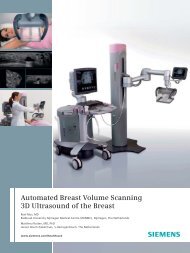
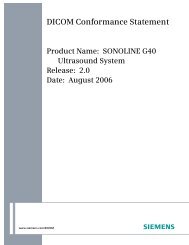
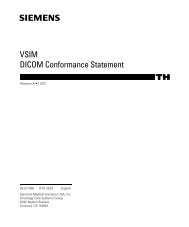

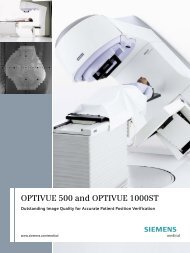
![WalkAway plus Technical Specifications [41 KB] - Siemens Healthcare](https://img.yumpu.com/51018135/1/190x253/walkaway-plus-technical-specifications-41-kb-siemens-healthcare.jpg?quality=85)
